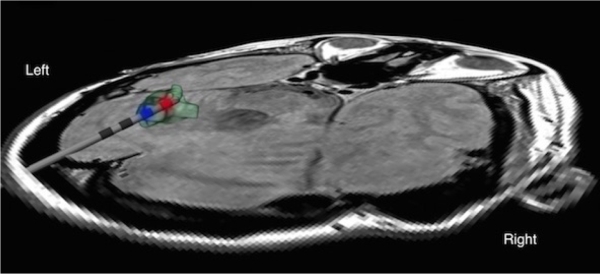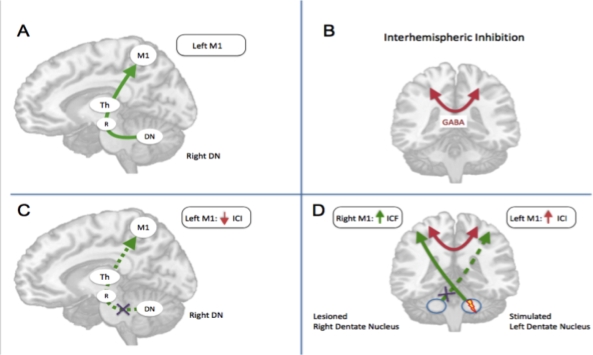Session Information
Date: Wednesday, June 22, 2016
Session Title: Ataxia
Session Time: 12:00pm-1:30pm
Location: Exhibit Hall located in Hall B, Level 2
Objective: To assess tremor and ataxia changes by dentate nucleus deep brain stimulation and evaluate how DBS could modulate cortical excitability seen in cerebellar stroke.
Background: Chronic cerebellar ischemic lesions have recently been associated with decrease in inhibition in the contralesional M1, leading to marked inter-hemispheric asymmetry in cortical excitability, which could account for part of the functional impairment seen after stroke. We hypothesized that DBS of dentate nucleus would balance the functional asymmetry seen between both M1 after chronic cerebellar and attenuate clinical symptoms.
Methods: We report a case of post-surgical right cerebellar hemisphere infarction in a fifty-year-old female. Based on the refractoriness of symptoms to medical treatment and a good response to TMS to the healthy dentate nucleus, deep brain stimulation to the left dentate nucleus was performed.  A blind movement disorder specialist evaluated the patient under on-stimulation and off-stimulation. Cortical excitability was evaluated by TMS.
A blind movement disorder specialist evaluated the patient under on-stimulation and off-stimulation. Cortical excitability was evaluated by TMS.
Results: Patient showed an improvement in tremor (FTMTS 38 – 24: 37%) and ataxia (SARA 25,5 – 17; 33%) one year after surgery. The Global Impression of Change went from 3 (i.e. no change) while in off-stimulation to 6 (i.e. moderately improved) in on-stim. During on-stimulation the cortical excitability has been normalised. 
| EC Parameters | ON-Stimulation | OFF-Stimulation | Normative date (>50 age) | ||
| MEP 120% (μV) | Right | 90.6 | 281.9 | 467.71±650.61 | Abnormal |
| MEP 120% (μV) | Left | 267.5 | 190.3 | 467.71±650.61 | Abnormal |
| MEP 140% (μV) | Right | 894.6 | 521.5 | 1172.43±1158.47 | Abnormal |
| MEP 140% (μV) | Left | 1200 | 1300 | 1172.43±1158.47 | Abnormal |
| ICF 10ms (μV) | Right | 4.51 | 0.87 | 2.46±3.85 | Normal |
| ICF 10ms (μV) | Left | 0.81 | 1.13 | 2.46±3.85 | Abnormal |
| ICF (μV) | Right | 3.77 | 1.39 | 2.28±3.32 | Normal |
| ICF (μV) | Left | 0.65 | 2.39 | 2.28±3.32 | Abnormal |
Conclusions: This was the first controlled, neuronavigation-guided deep-DBS study aiming at ataxia and tremor control. Our findings in cortical excitability might shed a light on the physiopathology of cerebellar dysfunction. In our patient, the clinical improvement after DBS remained until the last evaluation (two months). The study protocol was safe and well tolerated, and it provides evidence for larger studies using DBS in this patient population.
To cite this abstract in AMA style:
C.C. França, M.J. Teixeira, D. Ciampi de Andrade, R. Galhardoni, V.R. Barboza, V. Silva, G. Lepski, E.R. Barbosa, R.G. Cury. Deep brain stimulation of the dentate nucleus improves ataxia and modulates cortical excitability [abstract]. Mov Disord. 2016; 31 (suppl 2). https://www.mdsabstracts.org/abstract/deep-brain-stimulation-of-the-dentate-nucleus-improves-ataxia-and-modulates-cortical-excitability/. Accessed December 28, 2025.« Back to 2016 International Congress
MDS Abstracts - https://www.mdsabstracts.org/abstract/deep-brain-stimulation-of-the-dentate-nucleus-improves-ataxia-and-modulates-cortical-excitability/
